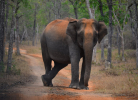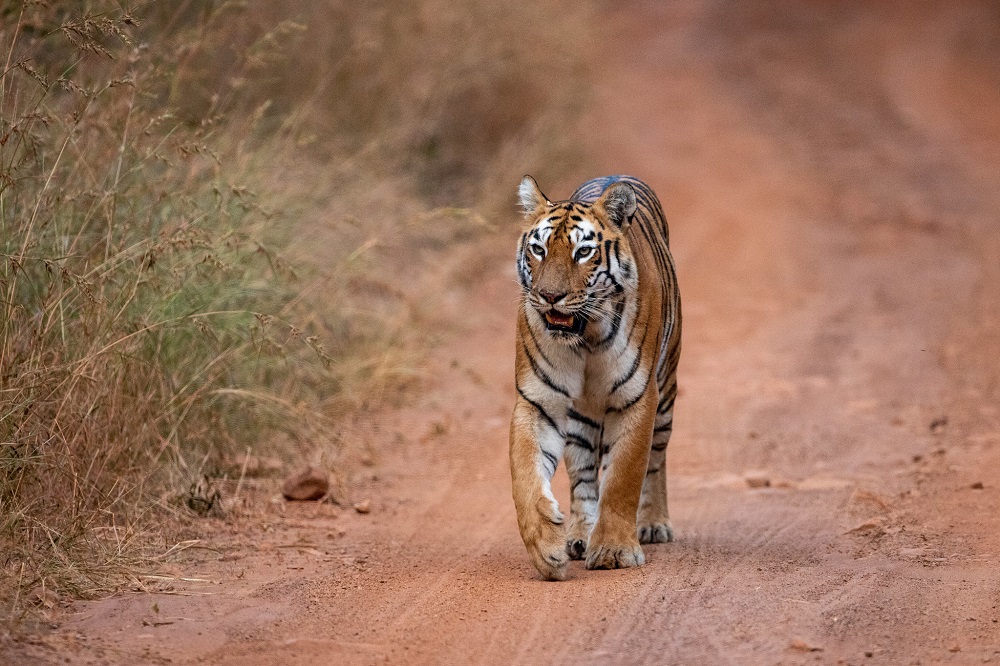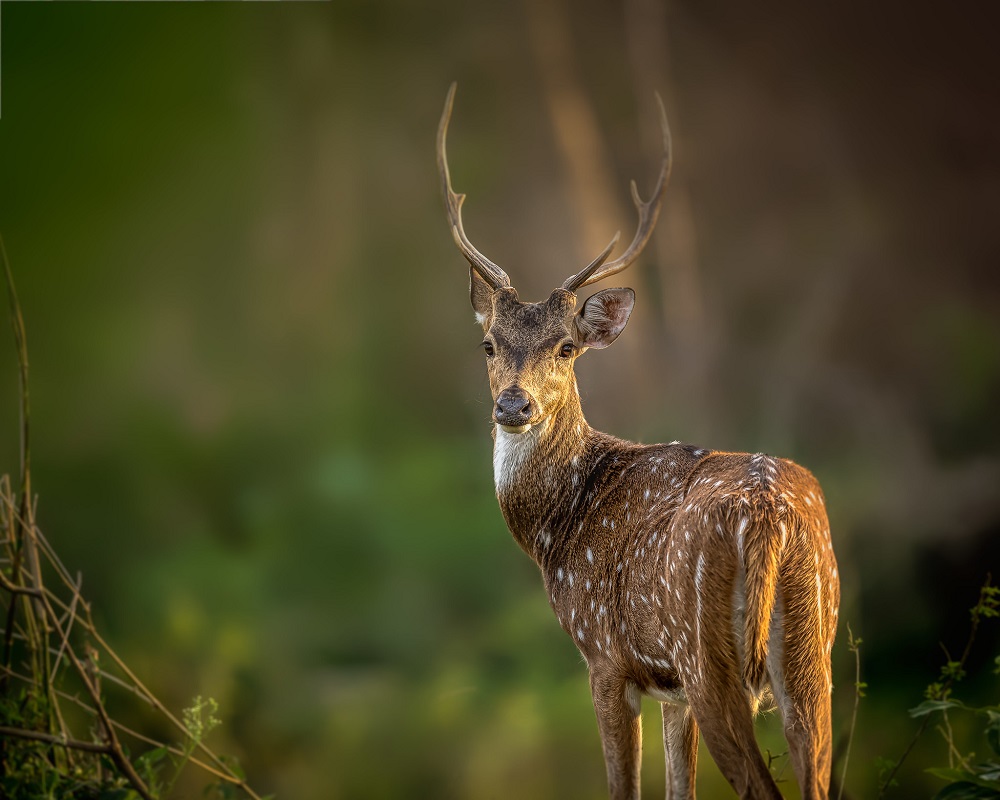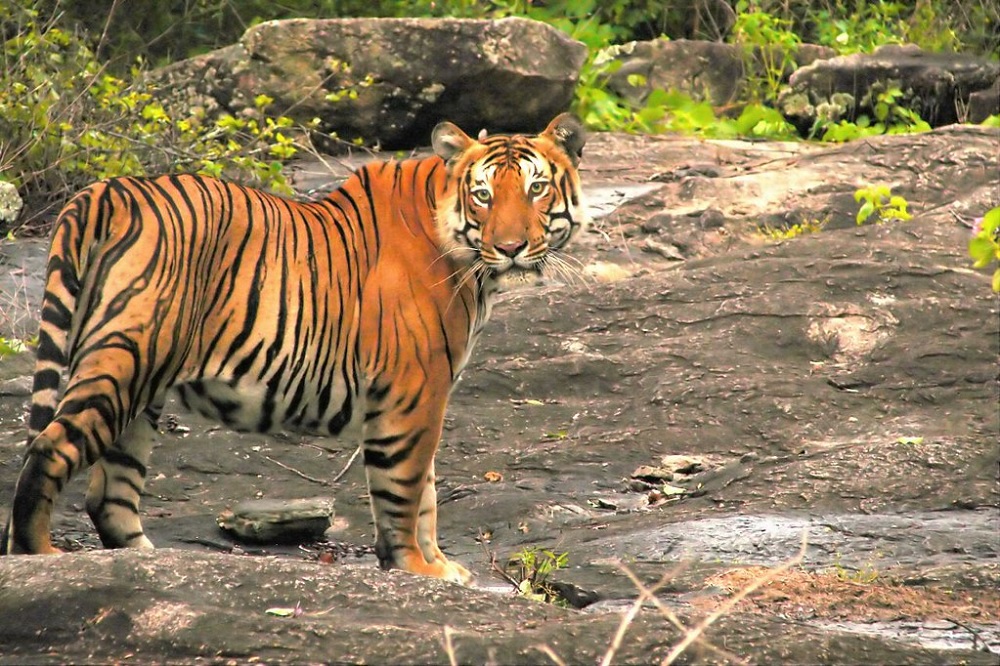Panna National Park
Panna National Park is located in Chahatarpur and Panna district of Madhya Pradesh. The park covers 542 square kilometer area and is the 22nd tiger reserve of the country. The park was recognized as the best-maintained park in 2007 by the tourism department of India. In 2009, the tiger population in the park was washed out by poaching. Later, measures were taken to increase the tiger population in the park.
The park is located in a spot where the tropical and subtropical forest belts are found. It starts from Cape Comorin, Tamil Nadu to Gangetic plains. River Ken runs through this relatively dry national park providing water to the wildlife throughout the year. Many rare species and endangered species can be spotted in this park. There are six species of vulture found in this park. Renah falls inside the park is an important tourist attraction. The waterfall is best during early winter. Paradise flycatcher is very commonly found in this region.
Different Areas in the Park
The park is divided into three regions namely, Tadoba north region, Morhurli region and the Kolsa south range. There are three water sources in the park namely Tadoba river, Tadoba lake and the Kolsa lake. Safari is allowed in all three regions.
Madla : This is one of the entrances to the park. Hiring guides and vehicles are easier here. Animal distribution in this area is high. Many herbivorous and large mammals can be spotted in this region. Flora is also rich here.
Hinouta : This is also an entrance to the park. The terrain in this region is predominantly rocky and dry. It is the best spot to find some wild cats including tiger, leopard and others. Sloth bear can also be spotted.
River Ken : This is the best area to spot all kinds of animals. Birdwatching is common in this area. Reptiles can also be spotted here. Boat safari on the river is one of the top tourist activities in the park.
Flora of Panna National Park
The park has Vindhyansoil, which is apt for dry teak trees and dry mixed forests. The hot tropical climate of the region makes these the dominant vegetation of the park. Small grassland areas along the river, riverines, open woodlands and thorny woodlands are also found. Top flora in the park are teak, kardhai, bamboo, boswellia and others. In the open woodlands, trees that are commonly found are mahua, saja, bel, tendu, salai and others. In the borders of the park, teak is abundantly found. Elephant grasses are common in the grasslands.
Fauna of Panna National Park
Top animals to spot in the park are tiger, nilgai, sloth ear, sambhar, leopard and others. After total wash out of tiger population, a few tigers were relocated to the park and now, four to ten tigers are found in the park. Leopard, wild dig, hyena, wild cats caracal, wolf, sloth bear, chital, chowsingha, chinkara and sambar are the top mammals found in this park.
The park is famous for birdwatching. More than 200 species of birds including migration birds are found in this park. Top birds to spot are blossom headed parakeet, salty headed scimitar babbler, paradise flycatcher, white necked stork, honey buzzard and others.
A few reptile species, which includes Indian snakes, crocodiles and others,are found in this region. River Ken is the best spot to find reptiles like mugger, long snout gharial ad others. Vulture spotting is high near the river.
Best Time to Visit Panna National Park
Summer : Summer is very hot and dehydrating in the park. The park generally has a very dry climate and during summer, it will be excessively hot and unpleasant. However, it is the best time to spot animals including tigers. Since the hot climate dries up all the small water sources inside the park, animals with their cubs visit River Ken every day for quenching their thirst. Thus, boat safari during summer is the best for those who want to spot many animals. Summer temperature can go as high as 45 degree C.
Rainy : The rainfall season changes from year to year. Roughly, rainy season starts in June and ends by September. This is the worst time to visit the park. The animals hard to spot and birds will be resting in tree branches. The sky will be dark to clearly spot any wildlife. The terrain becomes muddy and sticky making bicycle tour and walking tour harder. Elephants cannot scale the park.The park is usually closed during rainy season. Check with the authorities before you plan a rainy vacation at Panna national park.
Winter : Winter starts in October and ends in February. November to January is the best time for birdwatching as the population of migration birds will be at the peak. The climate will be mild during the day and the nights are very cold.
Best Time to Visit Panna National Park
November to May is the best time to visit the park. If you are ready to tackle the hot tropical climate, visit between March and May. If you want to experience a mild climate and a lot of birds, visit between November and January.
Wildlife Safari in Panna National Park
Panna national park allowes boat safari and elephant safari. The boat safari is the best option for spotting animals that come to quench their thirst andfor birdwatching. Elephant safari is opted by people who want to spot tiger species at close quarters. The best of all is the night safari provided at Gangau. Many safari tours starts from Madla village near the park. The entrance to the park is located on the eastern side of the park. Formalities to enter the park takes around 20 minutes and thus, it is important to reach 30 minutes prior to the safari timing.
The park authorities do not provide jeeps. Private jeeps can be hired from outside for trip inside the park. The cost of the ride and timing depends on the service provider. Private vehicles like four-wheel petrol vehicle, diesel jeep or station wagon can be hired from Panna or Khajuraho.
From the Raneh fall entrance, light motor vehicle trip, bicycle tour, foot tour and buses are allowed. Auto rickshaw safari is also permitted in protected area. Check with the authorities about the timing and availability of these safaris.
Wildlife Safari Timings
Safari is open from 6:30 am to 10:30 am and, 2:30 pm to 5:30 pm
Evening safari is cancelled during every Wednesday. Only 63 vehicles can enter the park during a safari round.
How to reach Panna National Park
The nearest domestic airport is located in Khajuraho. The nearest international airport is in Delhi. There are flights to Khajuraho from Delhi through Varanasi. From Varanasi, many flights connect the city with Khajuraho, every day. From airport, many road transportations are available to reach Panna.
If travelling from Mumbai, Delhi or Chennai, Jhansi is the nearest railway station to the park. For those travelling from Varanasi or Kolkata, Satna is the nearest railway station. From Nagpur, Katni is the nearest one. From the railway station, cabs or buses can be hired to reach the park.
The nearest bus stand is located in Panna. The state is well connected with road system and thus, buses and cabs can be hired from any surrounding cities or states. From Khajuraho, there are direct buses to the park. There are government buses to Panna from Agra, Gwalior, Delhi, Jhansi, Bamitha and others.
Distance between major cities and Panna National Park
- Kahjuraho and Panna national park – 25 km
- Satna and Panna national park – 70 km
- Mahjhagawan diamond mine and Panna national park – 19 km
- Katni and Panna national park – 130 km
- Jhansi and Panna national park – 180 km
- Orchha and Panna national park – 230 km
- Bhopal and Panna national park – 727 km
- Delhi and Panna national park – 889 km
- Chennai and Panna national park – 1761 km
- Calcutta and Panna national park – 1040 km
Best Places to Stay in Panna National Park
- Jungle cottage, Hinauta
- Madla forest rest house, Panna national park
- Eco camp Hinouta, Panna national park
- Raneh fall hut, Panna national park
- Ken river lodge, Madla
- Pashangarh Taj safaris, Panna
- Panna tiger resort, Madla
- Jungle camp, Madla
- Payal and Jhankar, Khajuraho
- Lalit temple view, Khajurago
Conservation History of Panna National Park
The north and south Panna forest region along with Panna national park are the only remaining wildlife habitat in the state. In the past, the Panna forest region was a hunting preserve for the kings of Panna, Bijawar and Chhatarpur. In 1975, the north and south Panna forest were combined and named as Gangau wildlife sanctuary. In 1978, the sanctuary included Chhatarpur forest region into its borders. In 1981, it was named as the Panna national park. In 1994, the park was tagged as a tiger reserve with 40+ tigers.
In 2009, two tigresses were bought from other parks to tackle the declining tiger population. But, no male tiger was spotted in the park. The reason for declined in the tiger population was not shared with the public. It was assumed to be due to illegal hunting by the officials of the park. In 2009, two tigress and a male tiger were found in the park and the male tiger disappeared. The whereabouts of the tiger is still not known. In 2010, a tiger was bought into the park and slowly their population gained momentum. Today 4-10 tigers are found.
















